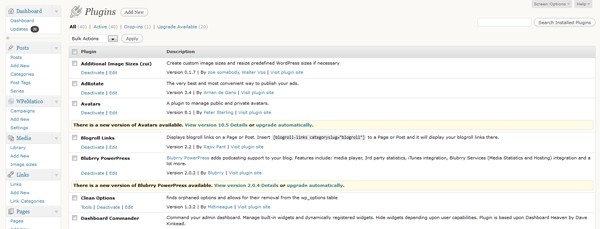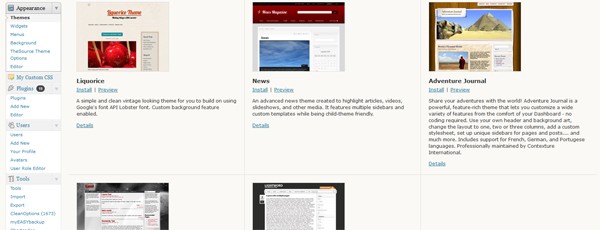If you're looking into WordPress as a Content Management System (CMS) for your website you came to the right place. Though there are many CMS options available, I'll explain why WordPress is one of the best.
Price Range
WordPress is an open source project, which means it was created by and for the community. It also means you are free to use it for any type of website without paying anyone a license fee. But not everything is free; WordPress has many features including a plugin architecture and a template system where anyone can develop and charge for their plugin or theme. You'll get everything you need in the WordPress install to build a basic free site. However, if you want to take advantage of the CMS (CMS's are built as an easy way to add content, images, videos, audio, etc. to your site; they are not built as a tool for designing websites) and use plugins that will instantly give you social sharing, or a theme that will instantly give you a nice looking site, then while there are free options you may have to pay for a quality or custom solution. Though WordPress is free you will also still need to purchase a host.
Hosting
WordPress won't run by itself, so you'll need a host to store and run it. A web hosting service is a type of internet hosting service that allows individuals and organizations to make their own website accessible via the World Wide Web. Web hosts are companies that provide space on a server they own or lease; an example of a host is GoDaddy or Hostgator. Hosting usually ranges from around $10 - $30 a month for sites that don't plan on getting too large, or $150 - $300 a month for sites that want to run quickly with a large amount of visitors. The difference is shared servers and dedicated servers.
Shared servers are shared by a number of different websites. Picture it as if you rented (shared) a home with 20 other friends. Though the rent is cheap your daily process takes a lot longer than normal, meaning your site at times will load slower than normal and there is nothing you can do unless you upgrade to a larger server.
Unlimited storage means unlimited, but don't get carried away with it. Picture yourself as a hoarder that owns a small furnished studio. Since you don't have much storage over the years objects start to pile up. Closets become full; corners become closets; floor space becomes storage space. Next thing you know you have only a walkway from your kitchen to your front door and Hoarders, the TV series, is doing a show on you. What I'm trying to say is though you have unlimited storage the more stuff you put on your server the slower your site runs. A quick fix is to not have an archive of files older than 3 months, and delete large files like audio or video that are older than 3 months.
Don't let me scare you away from purchasing a shared server, because it could be all that you need. One idea is to run your site on a shared server until you out grow it with visits and storage and then upgrade to a stronger server, so prepare yourself for expansion.
Now dedicated servers you pay twice as much for not as much. That is because you are the only one on the server, no sharing, so it runs quick and supports any website size. You'll notice they don't offer any type of unlimited storage. For some hosting in order to purchase a dedicated server you have to know how to run it, so be sure to check with your host if they provide this kind of support or server management.
A good host that specializes in WordPress hosting is WP Engine or Page.ly. They run a dedicated like server that is engineered to run specifically for WordPress.
As well, it is important to have file storage outside of your hosting plan, read more about this below in file hosting.
Control
WordPress runs as a CMS smoothly, but what makes it great is how much control you have. You can code any part of WordPress to function the way you want. You have access to all files and folders. If you know PHP or are a quick learner you can make a masterpiece quickly. You can also make a plugin or theme to install into your WordPress. Turn plugins on and off with one click and redesign your site with a simple and quick theme install. With the vast amount of themes and plugins available for downloading, anything is possible.
User Interface
The admin section of WordPress is easy to figure out; making posts, pages, installs and updates is a breeze. The WYSIWYG editor gives you everything you need to post a story to your site, from bold or left-align to an HTML tab. Publish a post or schedule it for another day; password protect a page or allow commenting on your site. It's all displayed with a visually pleasing user interface.
Upgrading WordPress
WordPress needs upgrading quite often to keep software up-to-date with the latest security fixes, user interface changes, new features and more. This can cause problems when you have to have certain plugins for your site. Because as WordPress upgrades, not all plugins upgrade; due to the developer's dedication and time. This means they may not work with the newest WordPress version.
Also, if you make any changes to the files and folders included in the main WordPress installation, when you upgrade you will lose all changes. This is one of the reasons we recommend you never make changes to core WordPress files. But, WordPress doesn't have to be upgraded to the newest version to work. Once you install WordPress (whichever version it may be) and add plugins, if you were not to upgrade WordPress or plugins your site would still function properly. But it is best practice to upgrade WordPress when a new version is available. Before upgrading always remember to backup everything; your theme, plugins, database and main WordPress installation.
Customer Support
If you're going to need a lot of help building your site you can use the WordPress forums to help answer your questions. It is an open source community, meaning those helping to answer problems are often volunteers, so sometimes you may need to work through and resolve your own problems. Since emailing support is not available (because it's not a good way to help out a lot of people) consider a host with WordPress support like WP Engine or Page.ly. Not all hosting companies offer WordPress support, so choose your shared server host carefully.
Plugins

Plugins are tools to extend the functionality of WordPress. With all the available plugins you can turn WordPress into a radio, news or photography content management system as easy as installing software.
Over 18,000 plugins are available; some are free, others ask for donation or have a monthly rate or one-time buy. With that many plugins it provides an opportunity to build a site the way you want it.
Let's say you're building a newspaper site. Download theme my login to handle membership subscription to your online paid version. WPeMatico for automatic publishing from an affiliate newspaper to your website. AdRotate for scheduling of online business advertising. Font-Resizer to display small, medium or large font size for reading articles. Simple Weather to display your local weather. Related Posts to promote other stories related to the current story the user is reading and Me Likey for Facebook share buttons.
Another plugin that is useful for any type of website is MobilePress, which provides a separate theme for your mobile devices.
Not all plugins work for all versions of WordPress. Some plugins die off after a certain amount of time, or stop updating to be compatible with newer versions of WordPress. Before downloading a plugin make sure they have some kind of support and plan on upgrading the plugin as WordPress upgrades. Remember not to get too carried away with how many plugins you download, and choose them carefully. Having lots of plugins installed will make your website load slower, so always make sure a plugin has a good rating and is regularly updated. Poorly developed plugins and of course the amount of files, code and/or script that is being requested, can all slow your site down.
Themes

WordPress themes are files that work together to create the design and functionality of a WordPress site. Each theme may be different, offering many choices for site owners to instantly change the look of their website. There are free themes available through WordPress.org or premium themes for purchase all over the web. Think of it like you're hiring a web designer, the difference is that the theme is already finished, as opposed to waiting a couple of weeks.
Some themes provide drop down navigation menu settings, which gives you control of what goes where by dragging and dropping. Themes of all varieties are offered on the web, from media sites to shopping sites, so if you don't find something you like perhaps you're not looking hard enough!
Widgets

Designed to provide a simple and easy-to-use way of giving design and control to a section in your WordPress theme like a sidebar or a footer. Some plugins you download will provide a widget with options to display certain functionality in a different or quicker way. A very useful widget is the built-in HTML widget, which you can put any type of code or third party embed code in, besides PHP, but there is a plugin for that.
File Hosting
Though you can store files in WordPress it is not always the right choice, it depends on the size of your website. If you are a newspaper business that produces 4-5 stories a day then a file hosting alternative is necessary. Posting 4-5 stories a day with photos, audio and video, means that in time you'll have a lot of megabytes in your hosting storage and this will slow down your site. So you can either delete stories that are 3 months or older or give them a longer shelf life and use an alternative file hosting such as Amazon S3 or SoundCloud.
These storage services provide a fully redundant data storage infrastructure for storing and retrieving any amount of data, at any time, from anywhere. They are not free, but might save you from having WordPress posting issues because of time outs or slower load times on your site.
Wordpress Options
Every WordPress install comes with a variety of useful options.
- Comments – with a click of a mouse you can allow commenting on your posts that includes a log in infrastructure. Simply moderate comments by having WordPress hold comments based off the words you choose, or commenters you've approved before.
- Drop Down Navigation – they make it easy to drag and drop a link into your navigation menu.
- Editor – use the built in file editor to change code on your website files for small, quick edits.
- Post via E-Mail – post to WordPress by e-mail. You must set up a secret e-mail account with POP3 access. Any mail received at this address will be posted.
- Front Page Display – turn your homepage into a splash, static, or under construction page within seconds.
- Site Visibility – block search engines from seeing your site.
Strengthening WordPress
If you do decide to use WordPress as a CMS, then check out these articles to better your system.


Comments